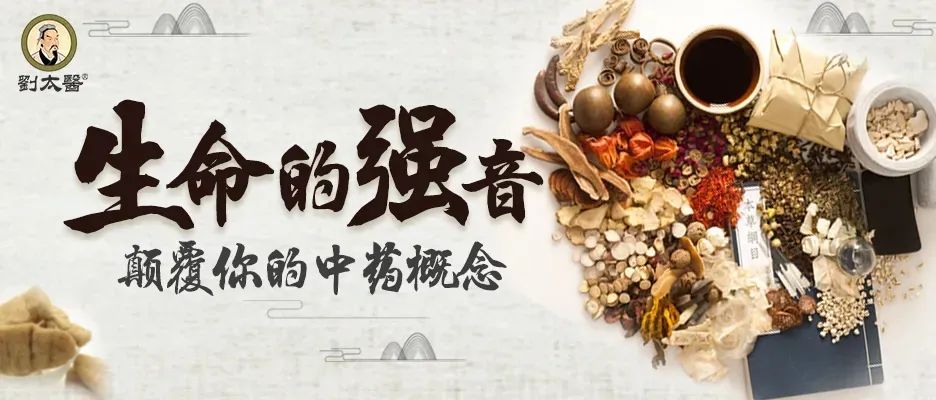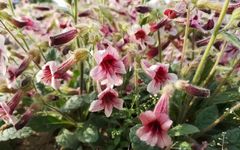Plant Morphology
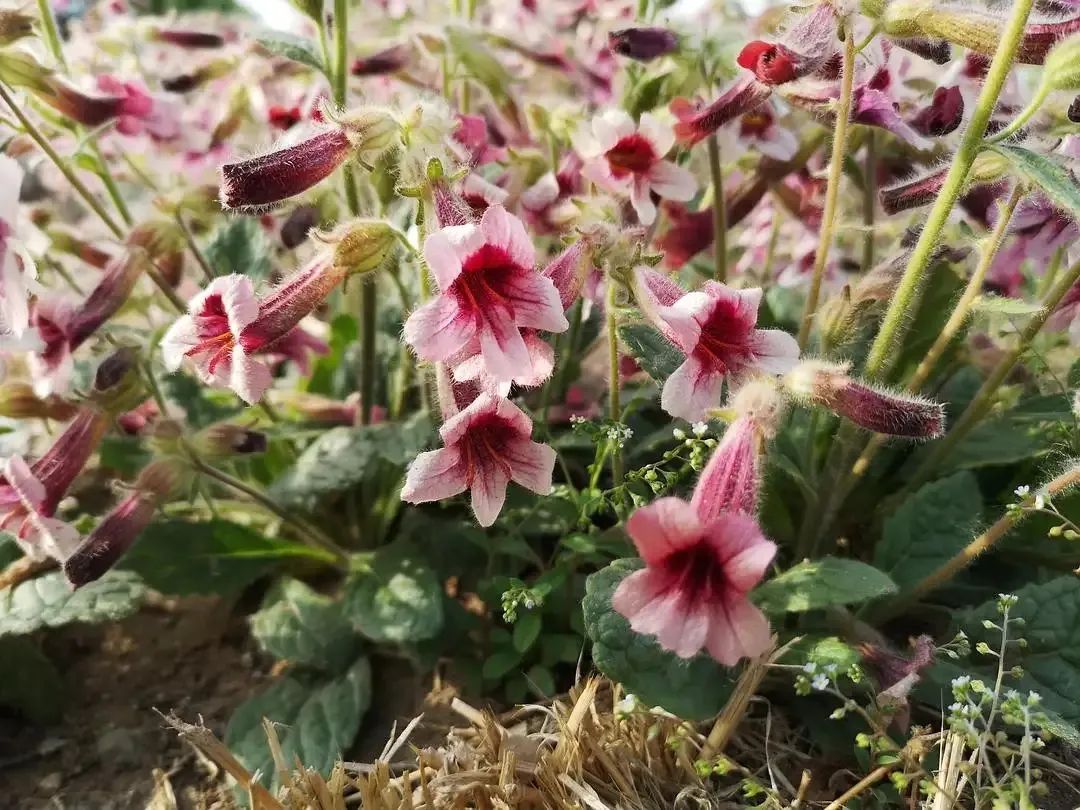 The plant Rehmannia glutinosa is a perennial herb, growing to a height of 10-70 cm. The entire plant is covered with grayish-white long soft hairs and glandular hairs. The roots are thick, fleshy, and tuberous, cylindrical or spindle-shaped. The stem is erect, either solitary or branched at the base. The basal leaves are clustered, lanceolate to ovate, with a blunt tip, gradually narrowing at the base into long petioles, the leaf surface is often wrinkled, and the edges have irregular serrations; the stem leaves are smaller. The flower stalk is erect, hairy, and forms a raceme at the upper part of the stem; the bracts are leaf-like, either well-developed or degenerated; the calyx is bell-shaped, with five lobes at the tip, the lobes are triangular, covered with long soft hairs and white long hairs, with 10 veins; the corolla is wide and tubular, slightly curved, dark purple outside, with yellow inside, having distinct purple stripes, with five shallow lobes at the tip, slightly bilabiate; there are four stamens, two of which are strong, with the anthers bifurcated at the base; the ovary is superior, oval, with two chambers, becoming one chamber after flowering, with one style and a swollen stigma. The capsule is oval or long oval, with a pointed tip, containing persistent styles, and is enveloped by the persistent calyx. There are many seeds. The flowering period is from April to May, and the fruiting period is from May to June.
The plant Rehmannia glutinosa is a perennial herb, growing to a height of 10-70 cm. The entire plant is covered with grayish-white long soft hairs and glandular hairs. The roots are thick, fleshy, and tuberous, cylindrical or spindle-shaped. The stem is erect, either solitary or branched at the base. The basal leaves are clustered, lanceolate to ovate, with a blunt tip, gradually narrowing at the base into long petioles, the leaf surface is often wrinkled, and the edges have irregular serrations; the stem leaves are smaller. The flower stalk is erect, hairy, and forms a raceme at the upper part of the stem; the bracts are leaf-like, either well-developed or degenerated; the calyx is bell-shaped, with five lobes at the tip, the lobes are triangular, covered with long soft hairs and white long hairs, with 10 veins; the corolla is wide and tubular, slightly curved, dark purple outside, with yellow inside, having distinct purple stripes, with five shallow lobes at the tip, slightly bilabiate; there are four stamens, two of which are strong, with the anthers bifurcated at the base; the ovary is superior, oval, with two chambers, becoming one chamber after flowering, with one style and a swollen stigma. The capsule is oval or long oval, with a pointed tip, containing persistent styles, and is enveloped by the persistent calyx. There are many seeds. The flowering period is from April to May, and the fruiting period is from May to June.
Properties of the Medicinal Material
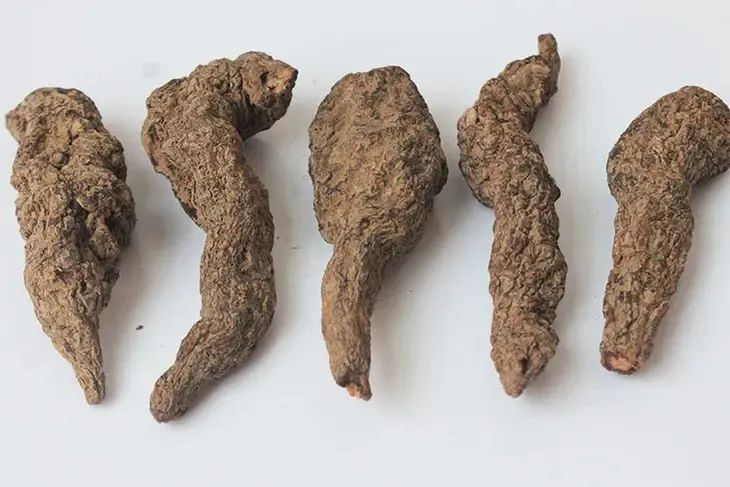
Sheng Di Huang (Raw Rehmannia):Often appears as irregular lumps or elongated shapes, with a bulge in the middle and slightly thinner ends, some are small, long, slightly flattened, and twisted, measuring 6-12 cm in length and 3-6 cm in diameter. The surface is brownish-black or brown-gray, very wrinkled, with irregular transverse grooves. It is heavy, soft, and tough, not easily broken, with a cross-section that is brownish-black or jet black, shiny, and sticky. It is odorless and has a slightly sweet taste.
Properties of the Processed Product
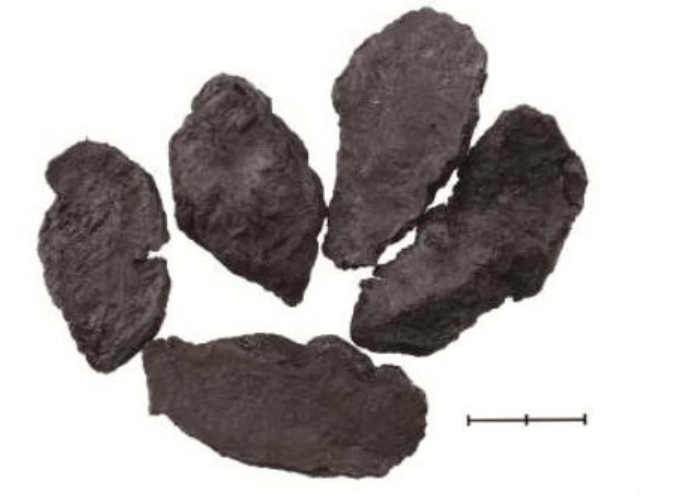
Shu Di Huang (Processed Rehmannia):Is a processed product of Sheng Di Huang, appearing as irregular chunks or fragments of varying sizes and thicknesses. The surface is jet black, shiny, and highly sticky. It is soft and has a certain toughness, not easily broken, with a cross-section that is jet black and shiny. It has a slight aroma and a sweet taste.
SourceThis product is derived from the roots and rhizomes of the plants Rehmannia glutinosa or Rehmannia glutinosa var. hueichingensis, processed by steaming and drying.Geographical DistributionIt is produced in most regions of the country, with significant production and quality found in Wenxian, Boai, and Mengxian in Henan Province.Harvesting and ProcessingSheng Di Huang is directly steamed until it becomes black and shiny, or stewed in wine until the wine is absorbed, then taken out, dried to about 80% dry or until the outer skin is slightly dry, cut into thick slices or chunks, and then dried.Properties and ChannelsIt is slightly warm in nature and sweet in flavor. It enters the Liver and Kidney meridians.Functions and IndicationsIt nourishes Yin and blood, warms and tonifies the Liver and Kidney, treats Kidney Yin deficiency, lower back pain, weakness of the legs, tinnitus, dizziness, insufficient Liver blood, women’s metrorrhagia, irregular menstruation, Yin deficiency cough, and diabetes.DosageFor internal use: 10-30 grams, or in pills, powders, or decoctions, or soaked in wine.PrecautionsThis product is sticky and can hinder digestion, so it is contraindicated for those with Spleen and Stomach Qi stagnation, phlegm-damp obstruction, abdominal distension, poor appetite, and loose stools.
Clinical Applications
For symptoms of deficiency and slippery (such as leucorrhea and enuresis)Shu Di Huang is combined with Shan Yao (Chinese Yam), where Shu Di Huang nourishes the Liver and Kidney, and Shan Yao benefits the Kidney and stabilizes essence. The combination of these two herbs significantly nourishes Yin and tonifies the Kidney, stabilizing essence and stopping leakage, benefiting both the Spleen and Kidney.For Qi and blood deficiency, symptoms include shortness of breath, fatigue, dizziness, pale complexion, and palpitations.Shu Di Huang is combined with Ren Shen (Ginseng), where Shu Di Huang is sweet, slightly warm, and moistening, nourishing without being drying, and is a key herb for nourishing blood and Yin; Ren Shen is sweet and tonifying, harmonizing the Spleen and Lung Qi, greatly replenishing Yuan Qi. Ren Shen tonifies Qi and supports Yang; Shu Di Huang nourishes blood and benefits Yuan Yin. The combination of these two herbs benefits Qi and blood, nourishing Yin and balancing both Yin and Yang.For symptoms of both Yin and Yang deficiencyShu Di Huang is combined with Rou Gui (Cinnamon), where Shu Di Huang sweetly warms and nourishes the Kidney to fill essence; Rou Gui warms and tonifies Kidney Yang and dispels cold. Shu Di Huang’s nature is to condense and quiet, nourishing the Kidney and filling essence, while Rou Gui’s warming nature enhances the dispersal of medicinal properties, strengthening the nourishing effects on the Liver and Kidney; Rou Gui’s warming nature promotes movement, while Shu Di Huang’s quiet nature preserves and nourishes, thus preventing excessive heat. The combination of these two herbs balances movement and stillness, harmonizing and tonifying Kidney Yang, benefiting essence and blood, nourishing Yin and assisting Yang, thus balancing Yin and Yang.
Liu Taiyi’s Export-Grade Authentic Medicinal Slices: Shu Di Huang
Shu Di Huang is derived from the roots and rhizomes of the plants Rehmannia glutinosa or Rehmannia glutinosa var. hueichingensis, processed by steaming and drying. It is slightly warm in nature, entering the Liver and Kidney meridians, and has the effects of nourishing blood, enriching Yin, and calming the spirit. It is a key herb in TCM for replenishing Yin, blood, essence, and fluids, holding an important position in traditional Chinese medicine.
Identification of Quality Shu Di Huang:
1. Appearance:Good Shu Di Huang has thick, fleshy roots that are not easily broken, with a cross-section that is jet black and has a high gloss.
2. Texture:Good Shu Di Huang appears moist, and when pressed with a finger, it can create a dent without feeling hard.
3. Taste:Good Shu Di Huang has a pure taste, is soft and glutinous when eaten, and has a sweet aftertaste, suitable for all ages.
Liu Taiyi’s authentic Shu Di Huang is characterized by thick, fleshy roots, jet black color, sweet taste, and soft, shiny texture, fully complying with the standards of the “Chinese Pharmacopoeia,” representing the authentic Shu Di Huang in medicinal sources.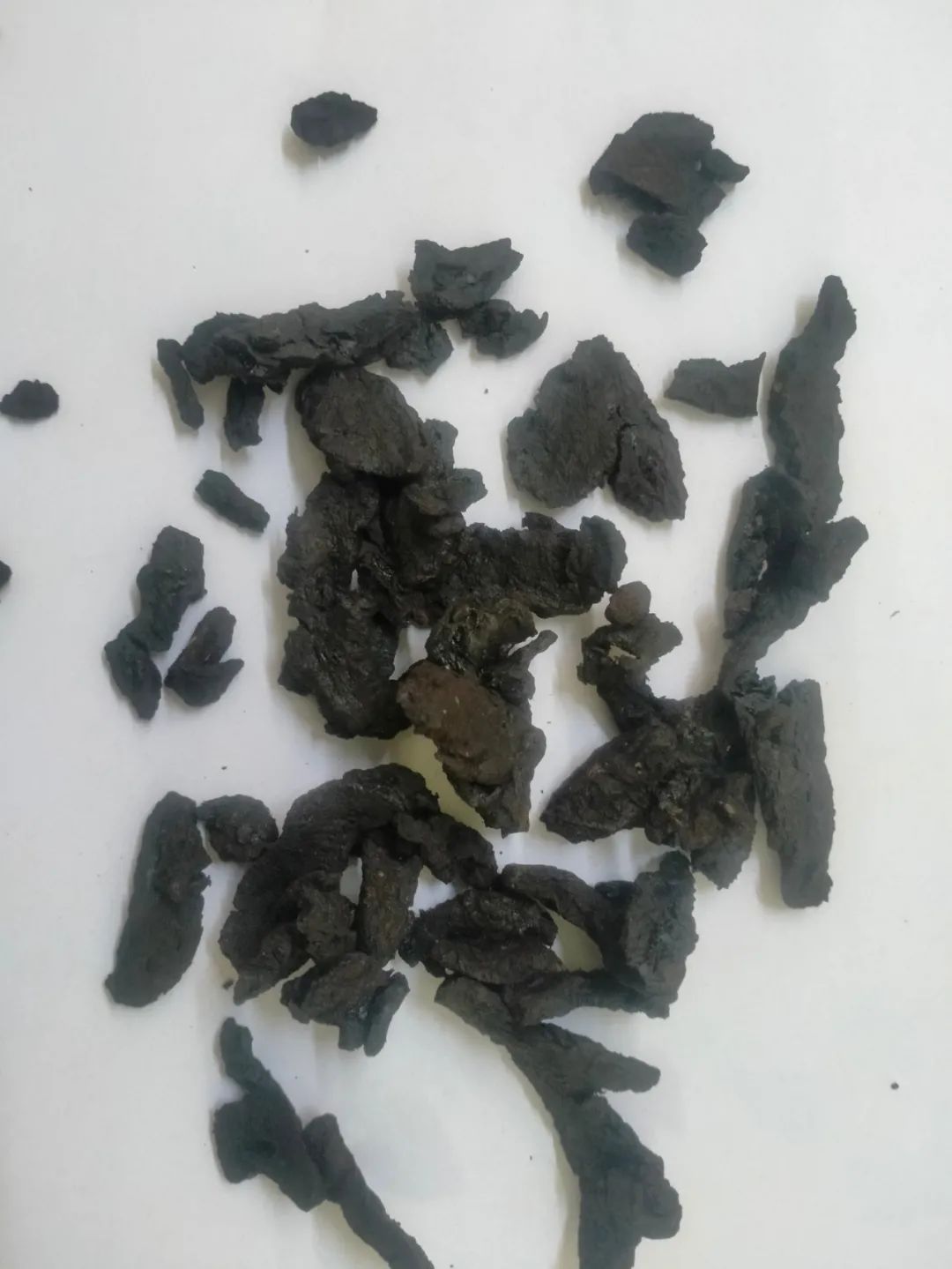 ▲Liu Taiyi’s Authentic Medicinal Material Shu Di Huang
▲Liu Taiyi’s Authentic Medicinal Material Shu Di Huang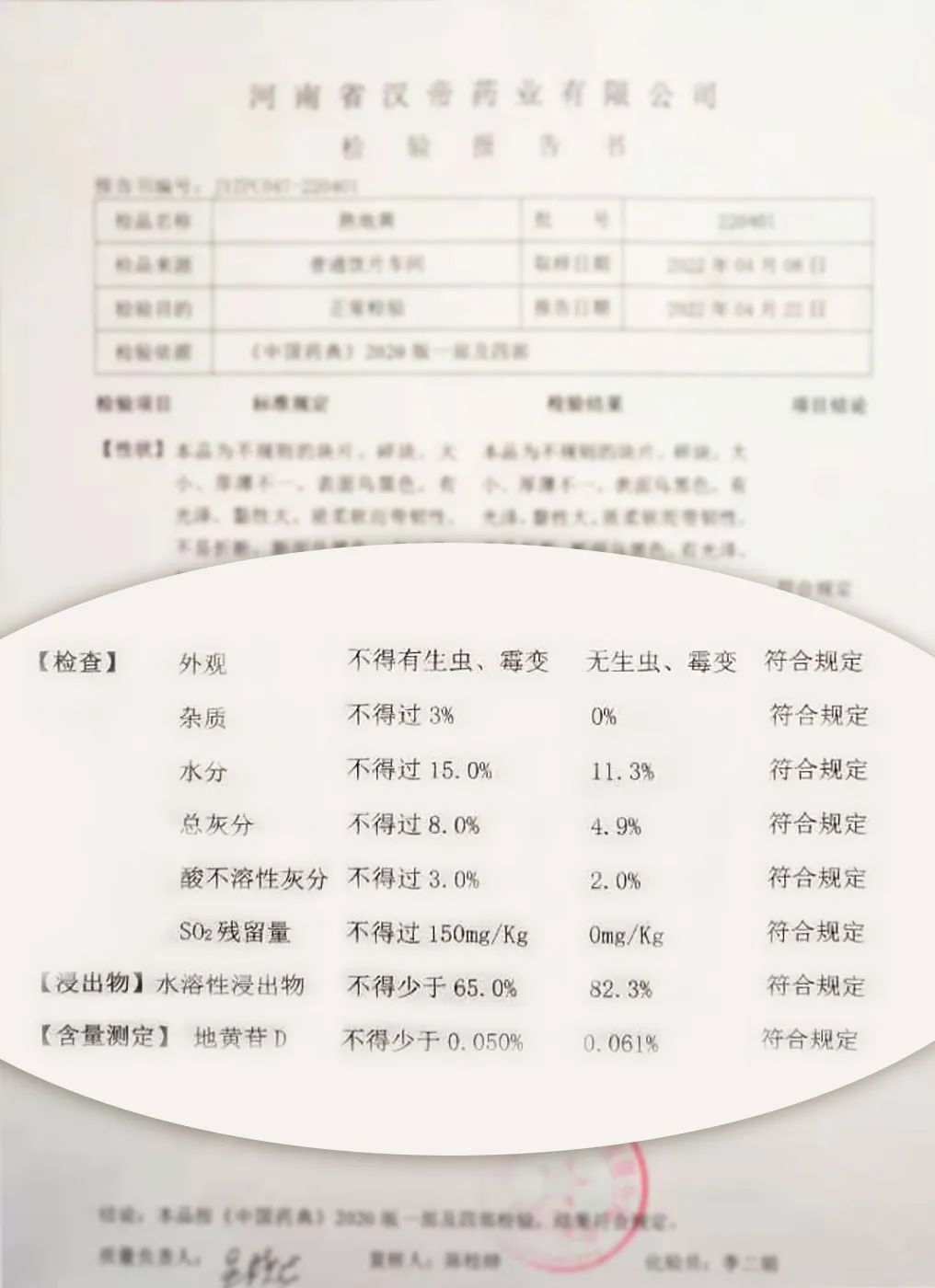
▲Liu Taiyi’s Authentic Medicinal Material Shu Di Huang Inspection Report
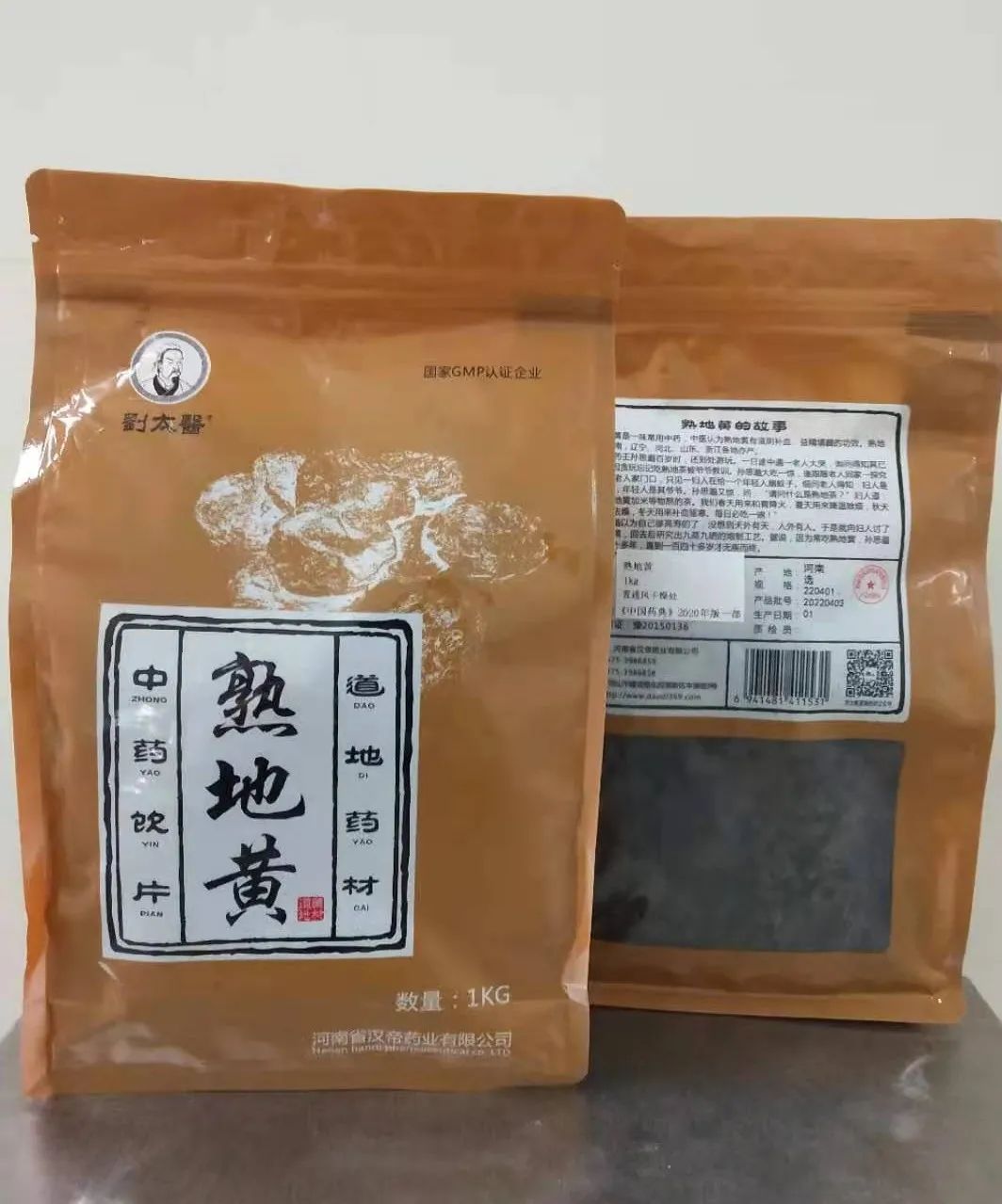 ▲Liu Taiyi’s Authentic Medicinal Material Shu Di Huang Finished Product
▲Liu Taiyi’s Authentic Medicinal Material Shu Di Huang Finished Product